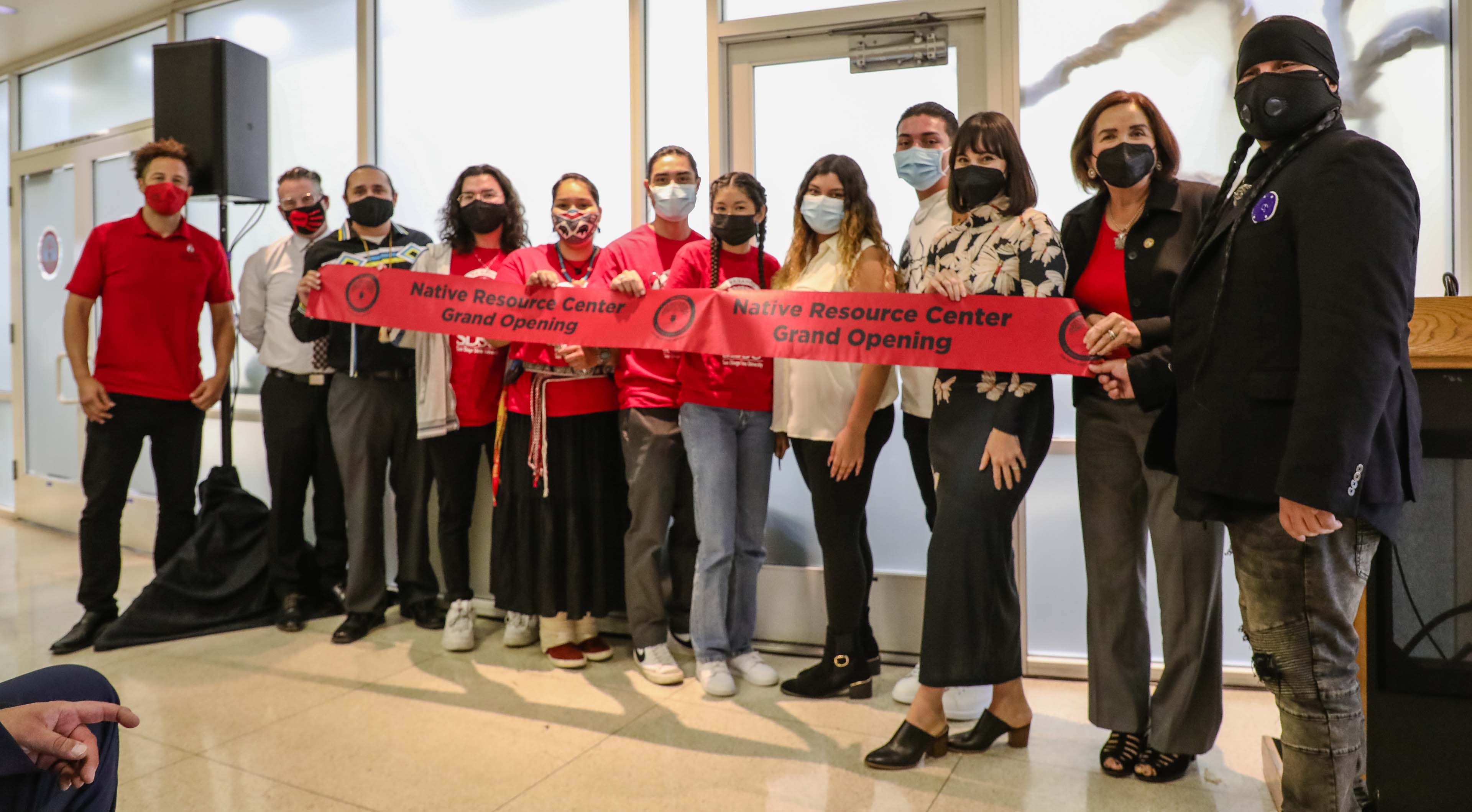Community is Key for New Native Resource Center
With a new location in West Commons, the center provides a welcoming environment for students from Indigenous populations.

Emotionally moving artwork covers the walls, and a quiet study area is all set just in time for fall semester finals. There are offices for mentoring and conferences and a lounge, all playing a part in a network of support.
The Native Resource Center at San Diego State University relaunched on Tuesday in new, more spacious quarters on the first floor of West Commons. The grand opening, timed for the end of National Native American Heritage Month, drew around 200 on-site visitors as others joined via livestream.
SDSU President Adela de la Torre told attendees she sees the new center as part of a slate of efforts at the university to right past wrongs inflicted upon Indigenous populations that date back for centuries.
“It is amazing that we have the privilege to walk together, to build this environment, to create opportunities so that when our Native students come to San Diego State, they can say this is home,” de la Torre said just before leading a ceremonial ribbon-cutting.
SDSU, which celebrates its 125th anniversary next year, was founded on Kumeyaay Nation land and serves a county with 17 federally recognized Tribal Nations. SDSU formally recognizes and respects that it resides on Kumeyaay land through its land acknowledgement.
Jacob Alvarado Waipuk (’14), SDSU tribal liaison, said the center is cause for excitement.
“It’s been a long time coming,” Alvarado said. “We actually have this here now for our kids, and for the future.”
The center transitioned from a previous home on the second floor of the Arts and Letters building. A grand opening celebration at that venue was booked for March 17, 2020, which turned out to be one day after the SDSU campus began to empty out in California’s response to COVID-19. The center continued to operate virtually, however, and resumed in-person operations when the campus repopulated over the summer.
As with its previous location, the center provides a space for students, faculty and staff from Kumeyaay and all Indigenous populations to share a welcoming environment and connect with their identity.
“The biggest thing that has really changed after somewhat coming out of the pandemic is the importance of community,” Chris Medellin, director of the center, said in a tour of the office a few hours before the ceremony. “We went for so long in our own individual spaces — our stay-at-home orders, isolated sometimes with families, sometimes not. We’re trying to relearn how to be in community again.”
“I think that’s one of the important things right now of these spaces,” Medellin added, “to really understand how we’re supposed to operate as a strong community.”
Besides Medellin, the center staff includes faculty scholar Gabriella Kovats Sánchez, who oversees the mentoring program focused on first-year and transfer students, and a program coordinator, expected to be hired in the spring 2022 semester.
Medellin co-authored the original proposal for the center while overseeing SDSU’s Elymash Yuuchaap Indigenous Scholars and Leaders Program.
Medellin, who belongs to the Yokuts tribe, has lived in San Diego his entire life and comes from a family on the Tule River Reservation. He said he didn’t feel connected with his native identity while he was an undergraduate at SDSU, working toward a degree in both American Indian Studies and television and film that he completed in 2014.
The center’s displays of Indigenous artwork, much of which benefits from the room’s natural light, includes two works by its assistant director, Jen Clay, an art therapist with a special interest in issues of Missing and Murdered Indigenous Women. One piece on display depicts three youth in clothing made of clippings of paper dealing with psychological disorders.
In a corner space is a print by Navajo artist Leander Begay, known for his skateboard deck designs (it will be joined later by one of the actual skateboards). The center also has a painting by Bunky Echo-Hawk, completed during an artist’s visit to SDSU in 2015, that speaks to the need to include Native Americans in educational curricula.
Additional speakers at the grand opening included J. Luke Wood, vice president for student affairs and campus diversity, and David Kamper, chairman of the American Indian Studies Department. John Christman, chairman of the Viejas Band of Kumeyaay Indians, performed traditional songs.
(Top photo: Participants in ribbon-cutting ceremony, from left, are Vice President for Student Affairs and Campus Diversity J. Luke Wood, American Indian Studies department chairman David Kamper, Native Resurce Center director Chris Medellin, students Mateo Gin Tarango, Jessica Becenti, Jerimy Billy, Skylar Beasley, Skyler Too-Koo-Par Morales and Derrick Herrer, Assistant Professor Olivia Chilcote, President Adela de la Torre and Tribal Liaison Jacob Alvarado Waipuk.)



